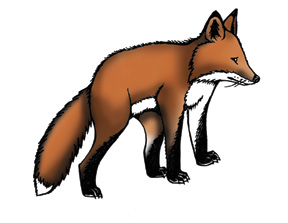

The red fox is common in many places all over the world, including Europe, Asia, North Africa and North America.
They are found in all habitats; including woodlands, farms, urban and coastal areas.
They are easy to identify with their reddish body, white tipped, fluffy tail and black legs. They weigh about 10 pounds.
Mostly active at night (nocturnal), red fox are also often seen during daylight hours on golf courses or open fields, trotting along with their fluffy tails held out. They travel alone. They can carry rabies.
They are scavengers, eating what they can find, but will also hunt and kill small animals and raid nests for eggs.
Their main predator is man.
Red fox breed once a year, mating in January or February. The females are pregnant for about 7 weeks (gestation), having 4-5 pups. They have their young in dens dug under trees roots, piles of brush or even trash. They will also den in tree cavities or rocky crevices. Males will stay to help raise young.
They live for about 3 years in the wild. They are not threatened.
Kingdom: Animalia
Phylum: Chordata
Subphylum: Vertebrata
Class: Mammalia
Order: Carnivora
Suborder: Caniformia
Family: Canidae
Genus: Vulpes
Species: Vulpes vulpes
When you research information you must cite the reference. Citing for websites is different from citing from books, magazines and periodicals. The style of citing shown here is from the MLA Style Citations (Modern Language Association).
When citing a WEBSITE the general format is as follows.
Author Last Name, First Name(s). "Title: Subtitle of Part of Web Page, if appropriate." Title: Subtitle: Section of Page if appropriate. Sponsoring/Publishing Agency, If Given. Additional significant descriptive information. Date of Electronic Publication or other Date, such as Last Updated. Day Month Year of access < URL >.
Amsel, Sheri. "Fox (Red)" Exploring Nature Educational Resource ©2005-2024. December 13, 2024
< http://www.exploringnature.org/db/view/334 >

